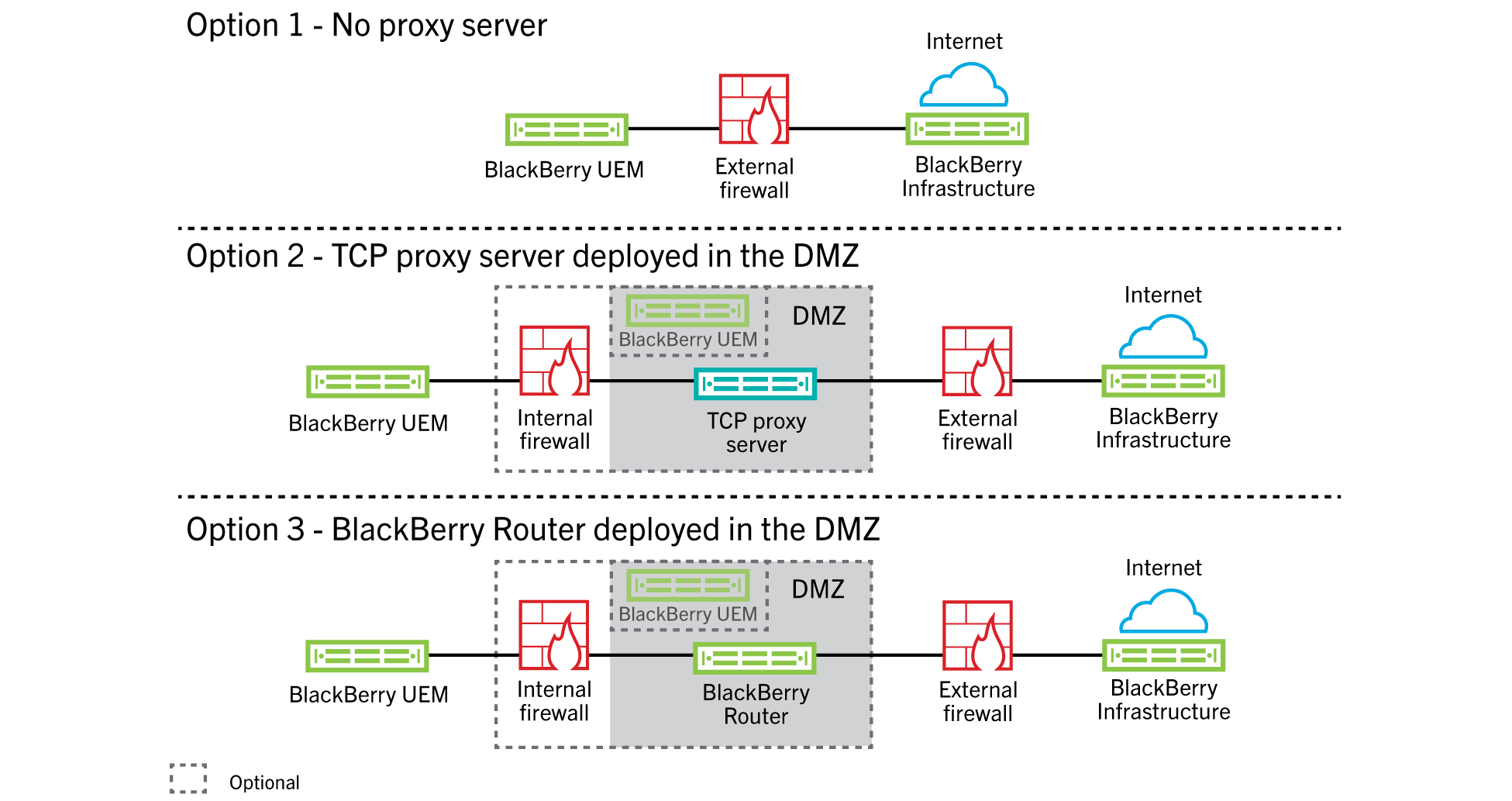- Configuring BlackBerry UEM for the first time
- Changing BlackBerry UEM certificates
- Configuring BlackBerry UEM to send data through a proxy server
- Configuring connections through internal proxy servers
- Connecting to your company directories
- Configuring Microsoft Active Directory authentication in an environment that includes Exchange linked mailboxes
- Connect to a Microsoft Active Directory instance
- Connect to an LDAP directory
- Enable directory-linked groups
- Enabling onboarding
- Synchronize a company directory connection
- Removing a connection to a company directory
- Connecting to an SMTP server to send email notifications
- Configuring database mirroring
- Connecting BlackBerry UEM to Microsoft Azure
- Create a Microsoft Azure account
- Synchronize Microsoft Active Directory with Microsoft Azure
- Create an app registration in Azure
- Configuring Azure Active Directory conditional access
- Configure BlackBerry UEM as a Compliance Partner in Azure
- Configure Azure Active Directory conditional access
- Configure the BlackBerry Dynamics connectivity profile to support the Azure Conditional Access feature
- Assign the Feature - Azure conditional access app to users
- Configure a BlackBerry Dynamics Profile
- Remove devices from Azure Active Directory conditional access
- Enable access to the BlackBerry Web Services over the BlackBerry Infrastructure
- Obtaining an APNs certificate to manage iOS and macOS devices
- Configuring BlackBerry UEM for DEP
- Configuring BlackBerry UEM to support Android Enterprise devices
- Extending the management of Chrome OS devices to BlackBerry UEM
- Setting up management of Chrome OS devices if you have already configured BlackBerry UEM to use Android Enterprise
- Create a service account that BlackBerry UEM uses to authenticate with your Google Cloud or Google Workspace by Google domain
- Enable additional APIs to allow BlackBerry UEM to sync the Chrome OS data
- Integrate BlackBerry UEM with your Google Cloud or Google Workspace by Google domain so you can use Chrome OS devices
- Synchronize BlackBerry UEM with the Google admin console
- Simplifying Windows 10 activations
- Migrating users, devices, groups, and other data from a source server
- Prerequisites: Migrating users, devices, groups, and other data from a source server
- Connect to a source server
- Considerations: Migrating IT policies, profiles, and groups from a source server
- Migrate IT policies, profiles, and groups from a source server
- Complete policy and profile migration for BlackBerry Dynamics-activated users
- Considerations: Migrating users from a source server
- Migrate users from a source server
- Considerations: Migrating devices from a source server
- Migrate devices from a source server
- Migrating DEP devices
- Configuring BlackBerry UEM to support BlackBerry Dynamics apps
- Manage BlackBerry Proxy clusters
- Configure Direct Connect using port forwarding
- Configure BlackBerry Dynamics properties
- Configure communication settings for BlackBerry Dynamics apps
- Sending BlackBerry Dynamics app data through an HTTP proxy
- BlackBerry Dynamics connectivity and routing behavior
- Default routing
- Example routing scenarios
- Scenario 1: Route traffic to specific servers or domains through BlackBerry Proxy
- Scenario 2: Route all traffic through the BlackBerry Proxy and then through a web proxy server
- Scenario 3: Route some traffic internally for most apps but configure a proxy server specifically for web browsing using BlackBerry Access
- BlackBerry Dynamics data flow
- Configuring Kerberos for BlackBerry Dynamics apps
- Connect BlackBerry UEM to a BlackBerry Dynamics PKI connector
- Integrating BlackBerry UEM with Cisco ISE
- Requirements: Integrating BlackBerry UEM with Cisco ISE
- Create an administrator account that Cisco ISE can use
- Add the BlackBerry Web Services certificate to the Cisco ISE certificate store
- Connect BlackBerry UEM to Cisco ISE
- Example: Authorization policy rules for BlackBerry UEM
- Managing network access and device controls using Cisco ISE
- BlackBerry Docs
- BlackBerry UEM 12.18
- Installation and configuration
- Configuration
- Configuring BlackBerry UEM to send data through a proxy server
Configuring BlackBerry UEM to send data through a proxy server
Configuring
BlackBerry UEM
to send data through a proxy serverYou can configure
BlackBerry UEM
to send data through a TCP proxy server before it reaches the BlackBerry Infrastructure
.By default,
BlackBerry UEM
connects directly to the BlackBerry Infrastructure
using port 3101. If your organization's security policy requires that internal systems cannot connect directly to the Internet, you can install a TCP proxy server. The TCP proxy server acts as an intermediary between BlackBerry UEM
and the BlackBerry Infrastructure
.You can install a proxy server outside your organization’s firewall in a DMZ. Installing a TCP proxy server in a DMZ provides an extra level of security for
BlackBerry UEM
. Only the proxy server connects to BlackBerry UEM
from outside the firewall. All connections to the BlackBerry Infrastructure
between BlackBerry UEM
and devices go through the proxy server.This image shows the following options for sending data through a proxy server to the
BlackBerry Infrastructure
: no proxy server, and a TCP proxy server deployed in a DMZ.